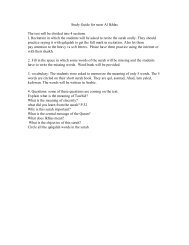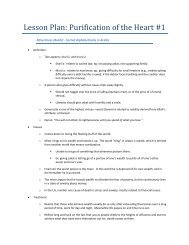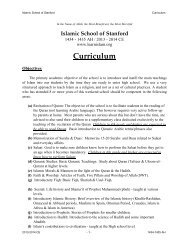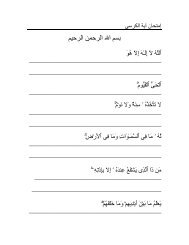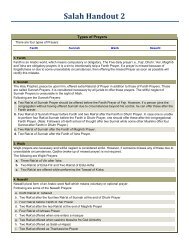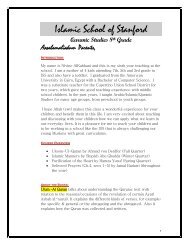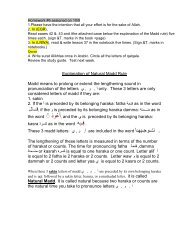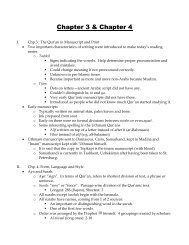Allah (SWT) says what can be translated as, “O Prophet! Fear Allah, and hearken not tothe Unbelievers and the Hypocrites” (TMQ, 33:1)There are many other ayahs that carry the same meaning as Allah (SWT) says what can betranslated as, “And obey not (the behests) of the Unbelievers and the Hypocrites, andheed not their annoyances, but put thy Trust in Allah…” (TMQ, 33:48)The fourth ayah focuses on devoting one’s obedience to Allah (SWT) alone when Allah(SWT) says what can be translated as, “Allah has not made for any man two hearts in his(one) body…” The fate of those who obey humans and not Allah (SWT) will be like thosewho say what can be translated as, “And they would say: “Our Lord! We obeyed ourchiefs and our great ones, and they misled us as to the (right) Path.” (TMQ, 33:67)The Surah confirms that this matter does not apply only to the Prophet (SAWS), but to all ofthe Prophets of Allah (SWT) when Allah (SWT) says what can be translated as, “Andremember We took from the Prophets their covenant: As (We did) from thee: fromNoah, Abraham, Moses, and Jesus the son of Mary: We took from them a solemncovenant:” (TMQ, 33:7)The surrender of the Heavens and the EarthThe Surah ends with on a gentle note; Allah (SWT) says what can be translated as, “We didindeed offer the Trust to the Heavens and the Earth and the Mountains; but theyrefused to undertake it, being afraid thereof: but man undertook it; - He was indeedunjust and foolish; - “(TMQ, 33:72)There are two types of ways to surrender to Allah (SWT). One can either submit to Allah(SWT) by one’s own choice and freewill, or can be a servant to Allah (SWT) without havingto choose. The first type is the one the heavens and the earth feared, knowing how uneasy isto carry the moral responsibility and perform duties. For this reason, they chose the secondtype of surrender, which is that of submission to Allah (SWT) without being given the choiceof fulfilling Allah’s commands.As for man, he has carried this moral responsibility – “…He was indeed unjust andfoolish…” However, the ayah does not mean that man is unjust and foolish because hecarries this responsibility but he will be so if he does not surrender to Allah (SWT) afterhaving taken it.For this reason, the conclusion of Surat Al-Ahzab is: Surrender to Allah (SWT) and knowthat He has entrusted you with a tremendous responsibility, one feared by even the grandestof Allah’s (SWT) creations. They preferred surrendering to Allah (SWT) without choice.The reason behind the Surah’s titleAs for the Surah’s name and how it came about, we must go back to the Battle of the Trench,in which Al-Ahzab (the allied parties) surrounded Madinah from every corner and every side.What was the Muslims’ reaction in this difficult situation? Allah (SWT) says what can betranslated as, “When the Believers saw the Confederate forces, they said: “This is whatAllah and his Messenger had promised us, and Allah and His Messenger told us whatwas true.” And it only added to their faith and their zeal in obedience. “ (TMQ, 33:22)
Do you see how the surrender to Allah (SWT) is constantly repeated throughout this Surah?However, there is another reason for the Surah’s name other than the Ahzab (the alliedparties) that appeared outside of Madinah. Internally, Madinah had been divided into groups:The group of hypocrites, the group of those who hesitated or were afraid and the third groupwhich we must not forget – the group of women who brought victory to Islam. There aremany ayahs in the Surah, which talk about this particular group, such as ayah 35 which canbe translated as, “…Verily, the Muslims (those who submit to Allah in Islam) men andwomen, the believers men and women (who believe in Islamic Monotheism)…” There isalso the group of believers who trusted have trust in Allah (SWT) and who had a wonderfultestimony from Allah (SWT were highly praised by Him) for their submission as Allah (SWT)says what can be translated as, “Among the Believers are men who have been true totheir covenant with Allah: of them some have completed their vow (to the extreme), andsome (still) wait: but they have never changed (their determination) in the least.”(TMQ, 33:23).Reconcile the groups…to establish civilizationThe Surah is named so for the many groups found both outside and inside of Madinah Thereis no doubt that reforming the groups inside of Medina and being victorious over them is, byfar, much harder than winning over the groups outside of the city. Allah (SWT) finished offthe former group by sending them a strong wind as mentioned in the ayah that can betranslated as, “…We sent against them a hurricane and forces that ye saw not…”(TMQ, 33:9). As for the groups inside, if they are reformed, our nation (of Islam) will beone of strong civilization, similar to that of Saba’, which is discussed in the Surah thatfollows this one. It is as if the relationship between the two Surahs is summarized in thefollowing statement: “O groups inside, surrender to Allah (SWT) and fuse together, for this isthe way to preserve civilizations”.The surrender of civilizations to Allah= Surat Saba’ (Sheba) =Surat Saba’, like Surat Al-Naml, is a Surah that discusses the issue of success in civilizations;it continues the meaning started by Surat Al-Naml. Surat Al-Naml focuses on working withthe building blocks of civilization, from education to technological development tomanagement, whereas Surat Saba’ asks those who wish to build a culture and a nation: Whatis the basis of this culture? What is the foundation? The objective of the Surah is theimportance and the need for of faith in modern civilization.The Surah discusses two contrasting types of civilizations: One that believes in Allah (SWT)and surrenders to Him, that of Dawud (AS) and Solaiman (AS) and one that disobeys Allah(SWT) and refuses His path, that is of Saba’.The Surah’s order in the Qur’an after Surat Al-Ahzab emphasizes, as mentioned earlier, thatreformation of the groups inside with faith is the path to building a strong civilization.Two civilizations on the scale
- Page 8 and 9: (TMQ, 48:30). Even in the creation
- Page 12 and 13: voice. Verily, the harshest of all
- Page 14: Finally, I would like to ask you th
- Page 17 and 18: Surat Al-Ahzab (The Allied Parties)
- Page 19: Messenger, and the home of the Here
- Page 23 and 24: A universal methodAfter presenting
- Page 25 and 26: know who will accept and follow gui
- Page 27 and 28: translated as, “he said, “O my
- Page 29 and 30: Thus he repented and turned back to
- Page 31 and 32: There is an Ayah in Surat “Al-Nah
- Page 33 and 34: it, and its gates will be opened, a
- Page 35 and 36: When Firaawn threatened to kill Mus
- Page 37 and 38: A person who performs Da’wa shoul
- Page 39 and 40: Surat Fussilat (Expounded), Surat A
- Page 41 and 42: ancient Egypt), which represented o
- Page 43 and 44: The aim of these Surahs is to make
- Page 45 and 46: translated as, “And they become d
- Page 47 and 48: “When Jesus came with clear signs
- Page 49 and 50: translated as, “They said, “Hav
- Page 51 and 52: Surat Muhammad, Surat Al-Fath (Conq
- Page 53 and 54: clear srah is sent down, and therei
- Page 55 and 56: The Truth: “Indeed you will defin
- Page 57 and 58: As we have mentioned, this Surah is
- Page 59 and 60: It is noticed that good conduct has
- Page 61 and 62: these Ayahs? They are for us to asc
- Page 63 and 64: Allah says what can be translated a
- Page 65 and 66: The wonder of Qur’an is crystal c
- Page 67 and 68: The ending of Surat An-Najm “So p
- Page 69 and 70: learning the Qur’an by heart, att
- Page 71 and 72:
cause it to grow, or are We the Cau
- Page 73 and 74:
“Then, in their wake, We followed
- Page 75 and 76:
Would you choose excessive material
- Page 77 and 78:
Women’s role in “Belonging”:A
- Page 80 and 81:
what you do” (TMQ, 58:3) - “…
- Page 82 and 83:
sacrifice dearly for the sake of th
- Page 84 and 85:
to you as emigrants, examine them;
- Page 86 and 87:
said: "We are Allâh’s helpers" (
- Page 88 and 89:
Their leader, Abdullah Ibn-Ubai Ibn
- Page 90 and 91:
Surat At-Tahreem (Divorce)= The Rol
- Page 92 and 93:
Surat Al-Qalam (The Pen), or Nun= M
- Page 94 and 95:
The Surah starts with the divine du
- Page 96 and 97:
Why can’t you be like them? Why d
- Page 98 and 99:
In Surat Al-Muddathir, on the other
- Page 100 and 101:
Surahs of the Thirtieth PartConclus
- Page 102 and 103:
man in the best form and shape. It
- Page 104:
− The importance of team-work,



